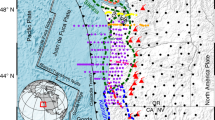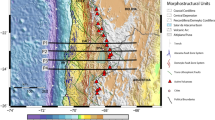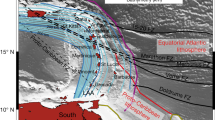Abstract
At subduction zones, oceanic lithosphere that has interacted with sea water is returned to the mantle, heats up during descent and releases fluids by devolatilization of hydrous minerals. Models for the formation of magmas feeding volcanoes above subduction zones require largescale transport of these fluids into overlying mantle wedges1,2,3. Fluid flow also seems to be linked to seismicity in subducting slabs. However, the spatial and temporal scales of this fluid flow remain largely unknown, with suggested timescales ranging from tens to tens of thousands of years3,4,5. Here we use the Li–Ca–Sr isotope systems to consider fluid sources and quantitatively constrain the duration of subduction-zone fluid release at ∼ 70 km depth within subducting oceanic lithosphere, now exhumed in the Chinese Tianshan Mountains. Using lithium-diffusion modelling, we find that the wall-rock porosity adjacent to the flowpath of the fluids increased ten times above the background level. We show that fluids released by devolatilization travelled through the slab along major conduits in pulses with durations of about ∼ 200 years. Thus, although the overall slab dehydration process is continuous over millions of years and over a wide range of pressures and temperatures, we conclude that the fluids produced by dehydration in subducting slabs are mobilized in short-lived, channelized fluid-flow events.
This is a preview of subscription content, access via your institution
Access options
Subscribe to this journal
Receive 12 print issues and online access
$259.00 per year
only $21.58 per issue
Buy this article
- Purchase on Springer Link
- Instant access to full article PDF
Prices may be subject to local taxes which are calculated during checkout



Similar content being viewed by others
References
Schmidt, M. W. & Poli, S. Experimentally based water budgets for dehydrating slabs and consequences for arc magma generation. Earth Planet. Sci. Lett. 163, 361–379 (1998).
Bebout, G. E. Metamorphic chemical geodynamics of subduction zones. Earth Planet. Sci. Lett. 260, 373–393 (2007).
Turner, S., Evans, P. & Hawkesworth, C. Ultrafast source-to-surface movement of melt at island arcs from Ra-226-Th-230 systematics. Science 292, 1363–1366 (2001).
Camacho, A. et al. Short-lived orogenic cycles and the eclogitization of cold crust by spasmodic hot fluids. Nature 435, 1191–1196 (2005).
Penniston-Dorland, S. C., Sorensen, S. S., Ash, R. D. & Khadke, S. V. Lithium isotopes as a tracer of fluids in a subduction zone melange: Franciscan Complex, CA. Earth Planet. Sci. Lett. 292, 181–190 (2010).
Zack, T. & John, T. An evaluation of reactive fluid flow and trace element mobility in subducting slabs. Chem. Geol. 239, 199–216 (2007).
Putnis, A. & John, T. Replacement processes in the Earth’s Crust. Elements 6, 159–164 (2010).
Scambelluri, M. & Philippot, P. Deep fluids in subduction zones. Lithos 55, 213–227 (2001).
Hermann, J., Spandler, C., Hack, A. & Korsakov, A. V. Aqueous fluids and hydrous melts in high-pressure and ultra-high pressure rocks: Implications for element transfer in subduction zones. Lithos 92, 399–417 (2006).
Ague, J. J. Extreme channelization of fluid and the problem of element mobility during barrovian metamorphism. Am. Mineral. 96, 333–352 (2011).
Spandler, C. et al. Redistribution of trace elements during prograde metamorphism from lawsonite blueschist to eclogite facies; implications for deep subduction-zone processes. Contrib. Mineral. Petrol. 146, 205–222 (2003).
Gao, J. & Klemd, R. Primary fluids entrapped at blueschist to eclogite transition; evidence from the Tianshan meta-subduction complex in northwestern China. Contrib. Mineral. Petrol. 142, 1–14 (2001).
Gao, J., John, T., Klemd, R. & Xiong, X. Mobilisation of Ti–Nb–Ta during subduction: Insights from rutile precipitates in eclogite-facies segregations and veins (Tianshan, NW China). Geochim. Cosmochim. Acta 71, 4974–4996 (2007).
Beinlich, A., Klemd, R., John, T. & Gao, J. Trace-element mobilization during Ca-metasomatism along a major fluid conduit: Eclogitization of blueschist as a consequence of fluid–rock interaction. Geochim. Cosmochim. Acta 74, 1892–1922 (2010).
Glodny, J., Austrheim, H., Molina, J. F., Rusin, A. & Seward, D. Rb/Sr record of fluid–rock interaction in eclogites: The Marun-Keu complex, Polar Urals, Russia. Geochim. Cosmochim. Acta 67, 4353–4371 (2003).
Klemd, R., John, T., Scherer, E. E., Rondenay, S. & Gao, J. Change in dip of subducting slabs at greater depths: Petrological and geochronological evidence from HP-UHP rocks (Tianshan, NW-China). Earth Planet. Sci. Lett. 310, 9–20 (2011).
Klemd, R. et al. New age constraints on the metamorphic evolution of the high-pressure/low-temperature belt in the western Tianshan mountains, NW China. J. Geol. 113, 157–168 (2005).
Veizer, J. Strontium isotopes in seawater through time. Annu. Rev. Earth Planet. Sci. 17, 141–167 (1989).
Ranero, C. R., Phipps Morgan, J., McIntosh, K. & Reichert, C. Bending-related faulting and mantle serpentinization at the Middle American trench. Nature 425, 367–373 (2003).
Amini, M. et al. Calcium Isotopes (δ44/40Ca) in MPI-DING reference glasses, USGS rock powders and various rocks: Evidence for Ca isotope fractionation in terrestrial silicates. Geostand. Geoanal. Res. 33, 231–247 (2009).
Richter, F. M. et al. Kinetic isotopic fractionation during diffusion of ionic species in water. Geochim. Cosmochim. Acta 70, 277–289 (2006).
Watson, E. B. & Baxter, E. F. Diffusion in solid-earth systems. Earth Planet. Sci. Lett. 253, 307–327 (2006).
Teng, F-Z. et al. Diffusion-driven extreme lithium isotopic fractionation in country rocks of the Tin Mountain pegmatite. Earth Planet. Sci. Lett. 243, 701–710 (2006).
Jamtveit, B., Austrheim, H. & Malthe-Sorensen, A. Accelerated hydration of the Earth’s deep crust induced by stress perturbations. Nature 408, 75–78 (2000).
Norton, D. & Knapp, R. Transport phenomena in hydrothermal systems—Nature of porosity. Am. J. Sci. 277, 913–936 (1977).
Baxter, E. F. & DePaolo, D. J. Field measurement of high temperature bulk reaction rates I: Theory and technique. Am. J. Sci. 302, 442–464 (2002).
Skelton, A. Flux rates for water and carbon during greenschist facies metamorphism. Geology 39, 43–46 (2011).
Ingebritsen, S. E. & Manning, C. E. Permeability of the continental crust: Dynamic variations inferred from seismicity and metamorphism. Geofluids 10, 193–205 (2010).
Oelkers, E. H. & Helgeson, H. C. Calculation of the thermodynamic and transport properties of aqueous species at high pressures and temperatures: Aqueous tracer diffusion coefficients of ions to 1000 °C and 5 kb. Geochim. Cosmochim. Acta 52, 63–85 (1988).
Marschall, H., Altherr, R. & Rüpke, L. Squeezing out the slab—modelling the release of Li, Be and B during progressive high-pressure metamorphism. Chem. Geol. 239, 323–335 (2007).
Acknowledgements
We acknowledge discussions with and proofreading by K. Mezger and A. Putnis. We thank S. Penniston-Dorland and H. Marschall for their constructive criticisms. The Deutsche Forschungsgemeinschaft financially supported this research through grant JO 349/5-1. Samples of AOC were provided by the Ocean Drilling Program.
Author information
Authors and Affiliations
Contributions
All authors participated in collecting the data and interpretation of the results; T.J. and N.G. took the lead in developing the final model. T.J. and R.K. focused on the fieldwork, N.G., T.J., R.H., G.E.B., H-M.S. and T.M. on geochemical methods and T.J., Y.Y.P. and R.D. on the Li chronometry.
Corresponding author
Ethics declarations
Competing interests
The authors declare no competing financial interests.
Supplementary information
Supplementary Information
Supplementary Information (PDF 1286 kb)
Rights and permissions
About this article
Cite this article
John, T., Gussone, N., Podladchikov, Y. et al. Volcanic arcs fed by rapid pulsed fluid flow through subducting slabs. Nature Geosci 5, 489–492 (2012). https://doi.org/10.1038/ngeo1482
Received:
Accepted:
Published:
Issue Date:
DOI: https://doi.org/10.1038/ngeo1482
This article is cited by
-
Changes in antimony isotopic composition as a tracer of hydrothermal fluid evolution at the Sb deposits in Pezinok (Slovakia)
Mineralium Deposita (2024)
-
Metasomatism at a metapelite–ultramafic rock contact at the subduction interface: Insights into mass transfer and fluid flow at the mantle wedge corner
Contributions to Mineralogy and Petrology (2023)
-
Early release of H2O during subduction of carbonated ultramafic lithologies
Contributions to Mineralogy and Petrology (2023)
-
Machine-learning techniques for quantifying the protolith composition and mass transfer history of metabasalt
Scientific Reports (2022)
-
Slab-derived devolatilization fluids oxidized by subducted metasedimentary rocks
Nature Geoscience (2022)



